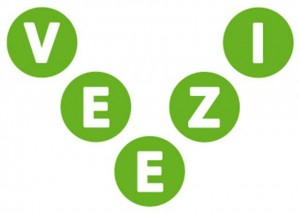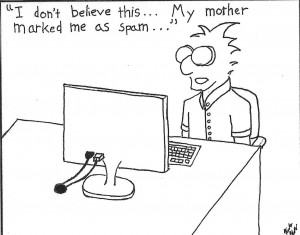Some work, some don’t
We all know that profits in the movie theater business are at the concession stand. We also know that increasing your average concession sale per customer—your per cap, is a critical function for a theater owner or manager, ranking just above food and shelter.
There are multiple methods to achieve this increase. The problem is that some of the methods work, some don’t, and it is not readily apparent which do and which don’t.
Here are nine common strategies to increase profits:
- Raise prices
- Increase product offerings
- Add combos
- Offer coupons
- Offer special concession pricing on particular nights
- Lower concession costs
- Improve signage
- Reduce lines at stand
- Train employees to upsell
Two of above work well, three can work OK, and four don’t work.
Here we go:
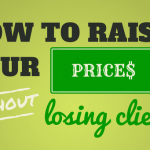 1. Raising prices
1. Raising prices
Works like a charm and here’s a little secret I’ve learned—you can raise prices more than you think you can. However, some caveats apply:
a. For maximum return with minimal damage, ticket and concession prices are best raised together and before a busy season. But don’t hesitate to raise concession prices alone if ticket prices are static but you feel concessions can be bumped up.
b. Do not raise concession prices too often—more than once a year, or on every single item. The theory is you don’t want to always seem to be raising prices.
c. Keep price increases reasonable; say 5% or 25 to 50 cents.
d. Keep in mind the next whole dollar amount; it’s easier to go from $3.25 to $3.75 than from $3.75 to $4.25.
e. Politely ignore customers who say, “Your prices are too high.” Customers always say your prices are too high and they will say this even as you are struggling to meet expenses. When your per cap goes down after a price increase, your prices are too high.
f. Err on the side of the smaller price increases as bad PR can be created by reaching the point described above.
 g. Note your competitor’s prices.
g. Note your competitor’s prices.
For comparison, the largest theater chain in the country, Regal Cinemas, had a chain-wide average concession per cap of $4.16 for 2015. This figure comes from Regal’s 10-K SEC filing for 2015. Well-run smaller theaters should average maybe 10-20% below the chain.
Do take into account pricing in your area as well; Regal might average $4.90 in expensive markets while lower priced markets might come in at $3.50. Art theater per caps are perhaps 2/3 of commercial per caps. Finally, all these figures have sales tax backed out.
2. Increase product offerings
For small to mid-size straight movie theaters — no bar or restaurant, this doesn’t work. You already know and offer the items that sell well and increasing the number you offer for the sake of a wider selection increases spoilage and complicates inventory.
Note that I’ve italicized small to mid-size movie theaters and no bar or restaurant because adding more product offerings at large or restaurant/bar theaters can increase sales, but these are different beasts; greater capital investments, higher operating expenses, etc.
3. Add combos
Works OK assuming you now only have 1-2 combos. A couple of thoughts:
a. Don’t have more than they say 3-4 combos; you can easily make things too complicated. Here are examples that usually work:
– Medium popcorn & drink or large popcorn & drink.
– Medium popcorn and drink with a candy
– Large popcorn and two medium drinks
– Whatever sells well at your theater
b. Offer a decent discount for buying the combo, at least $1, preferably $2. We’ve already raised the prices from #1, give them a nice break for buying a combo.
4. Offer coupons
 Works OK, it can break loose some sales that would otherwise have not occurred. Thoughts on coupons:
Works OK, it can break loose some sales that would otherwise have not occurred. Thoughts on coupons:
a. Offer a good discount for a decent sized sale; larger sales with larger discounts are a winner.
b. Track coupon redemption in your POS, otherwise you have no idea if they’re working.
c. Consider limiting concession coupon to Sun-Thurs, but don’t feel you must limit to off-peak. I personally don’t like limited coupons, but the spreadsheet indicates it makes sense to limit.
d. Most coupons are emailed with a bar code, but you can hand out to your customers as they exit. Print the offer big and bold and have a trash can ten feet down their walk path. If more than, say, 25% are in the trash your offer is not good enough.
e. If customers manage to get hold of the coupon from above on entry, just let it happen and don’t beat them up. It’s still a good sale.
5. Offer special concession pricing on particular nights
Doesn’t work, customers should have to work a little for discounts and this just gives them a discount for no effort. A better strategy is to have a discount ticket night, keep concession prices where they are and offer coupons, combos, etc.
6. Lower concession costs
This would work if you could do it, but you pretty much can’t. I’m assuming you’re already buying at the best price you can, being careful with spoilage on high cost items like baked goods and chocolate and keeping track of inventory. As a guide, your cost of goods for concessions should be 16-20% of sales; major circuits run 12-14%.
7. Improve signage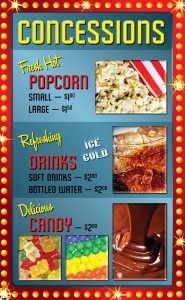
This can work but only if your current signage stinks. Signage must be easy to read and clear. The clear is where theater operators can miss the boat. They look at their sign every day and they think it’s clear, but then customers ask the same question over and over or spend 20 seconds figuring out what they want. That’s no good. 75% of customers should be able to look and find what they want in 3 seconds or less. So don’t look at your sign to see if it stinks, look and listen to your customers looking at your sign.
Finally, if you do have problems with your signage, consider consulting a sign professional. Signs are a specialty skill and the fact that you have sign software or did your Aunt Tilly’s signs at her organic egg market does not make you a good sign designer.
8. Reduce lines at stand
This paradoxically doesn’t work. You sure would think that having a shorter line would help concession sales, but studies show that it does not help, or increases sales only very minimally. People will wait in line. One theory of food lines even says the opposite; if the line is long, then the product is more desirable—kind of a herd mentality thing. The best advice is to staff according to what feels right and doesn’t create a line that is outrageously long or slow moving.
9. Train employees to upsell
This works. A few caveats.
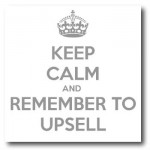 a. Training. Most employees are not born upsellers and they need training and managers that show by example how to upsell correctly and politely.
a. Training. Most employees are not born upsellers and they need training and managers that show by example how to upsell correctly and politely.
b. To start: You need your POS to suggest the upsell; you can’t expect employees to remember that when a customer buys a medium popcorn, they can add a drink for $1.75 more.
c. The upsell has to offer a good value—similar to a coupon, and should not have the customer adding more than, say, $2.
d. You should not program your POS to offer an upsell on every sale. The upsell offer is supposed to make sense and be a little special, no more than half of individual item sales should bring the employee to the upsell screen.
And if the customer just spent $20, then the POS should not go into upsell at all; it makes the employee look like a jerk when they say, “By adding $2 more to that last small popcorn, you can add a drink to go with the other 9 popcorns and 8 drinks.”
e. Most important, managers must lead by example. If you don’t, upselling will simply not happen.
Summary:
Do the following to increase concessions sales:
Raise prices when possible and institute an upselling program.
Consider doing the following to increase concessions sales:
Add combos, offer coupons, and improve signage.

